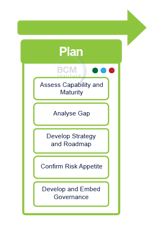Analyse the Gap
|
|
What is Incident and Crisis Management?Incident Management or IM refers to an organisation's activities to identify, analyze and correct threats. Crisis Management or CM is the overall coordination of an organization's response to a crisis in an effective, timely manner, intending to avoid or minimize damage to the organization's profitability, reputation, or ability to operate. |

 This section is the "Plan" phase of the Operational Resilience Planning Methodology. It is the second stage of the Plan phase: Analyse Gap.
This section is the "Plan" phase of the Operational Resilience Planning Methodology. It is the second stage of the Plan phase: Analyse Gap.
Audit Checklist for Analysing the Gap for Incident and Crisis Management
1. Crisis Management Structure |
|
|
Checklist |
|
2. Triggers and Activation Criteria |
|
|
Checklist |
|
3. Crisis Management Plans and Procedures |
- Are there comprehensive crisis management plans and procedures in place to guide actions and decisions during a crisis?
- Have the crisis plans been developed based on a thorough assessment of potential risks and scenarios?
- Are the plans regularly reviewed, updated, and tested for their effectiveness?
- Are there clear guidelines on the roles and responsibilities of senior management during a crisis?
- Is there a process for post-crisis evaluation and improvement of the crisis plans and procedures?
|
Checklist |
|
4. Tools and Processes for Situation Assessment |
|
|
Checklist |
-
Determine if tools and processes are in place to facilitate timely updating and assessment of the latest situation during a crisis.
-
Assess if a dedicated team is responsible for gathering, analysing, and disseminating information to support decision-making.
-
Verify if the tools and processes are regularly tested and updated.
-
Determine if there is a mechanism to integrate information from various sources and stakeholders for a comprehensive situational assessment.
5. Stakeholder Communication |
- Is there a list of internal and external stakeholders to be informed when a critical business service is disrupted?
- Are communication plans and requirements documented for each stakeholder group?
- Do the communication plans include criteria for determining the severity and timing of notifications?
- Are there predefined communication channels for efficient stakeholder communication, such as email distribution lists or notification systems?
- Are alternative communication channels identified and documented in case the primary channels are unavailable?
|
Checklist |
-
Verify if there is a list of internal and external stakeholders to be informed when a critical business service is disrupted.
-
Review communication plans and requirements documented for each stakeholder group.
-
Assess if the communication plans include criteria for determining the severity and timing of notifications.
-
Verify if there are predefined communication channels, such as email distribution lists or notification systems, for efficient communication with stakeholders.
-
Determine if alternative communication channels have been identified and documented in case the primary channels are unavailable.
6. Mainstream and Social Media Communication |
- Are communication channels effectively established to reach stakeholders through mainstream and social media platforms?
- Are designated personnel responsible for managing communications on these channels during a crisis?
- Are there guidelines or protocols to ensure consistent and accurate messaging through mainstream and social media?
|
Checklist |
|
Do note that some steps may overlap or appear similar in the other stages of the OR planning phases. If this occurs, the questionnaires and checklists must be contextualised to the topic under review.
 |
|||||
|
Questionnaires and Checklist "Plan" Phase |
Assess Capability and Maturity | Analyse Gap |
Develop Strategy Roadmap |
Confirm Risk Appetite |
Develop and Embed Governance |
 |
 |
 |
 |
 |
 |
Find out more about Blended Learning ORA-5000 [BL-ORA-5] & ORA-300 [BL-ORA-3]
 |
 |
 |
 |
 |
 |
 |
Please feel free to send us a note if you have any of these questions. |
 |



![Email to Sales Team [BCM Institute]](https://no-cache.hubspot.com/cta/default/3893111/3c53daeb-2836-4843-b0e0-645baee2ab9e.png)

